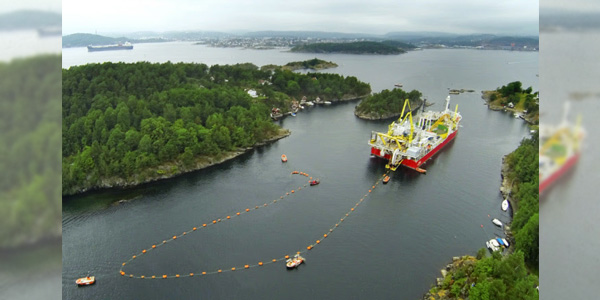With its sustainable development strategy and diverse natural resources, Canada is today the 4th leading country in the world for clean energy adoption with two thirds of its electricity generated by renewable resources[1]. To help meet Canadian federal regulations requiring a 50% reduction in coal emissions by 2030 and Nova Scotia regulations requiring 40% renewable energy by 2020, Nexans has installed North America’s longest submarine electricity cables as part of the Maritime Link Project conducted by NSP Maritime Link Inc. (NSPML), an indirect subsidiary of Emera Inc.
The delivery of two 200 kV mass impregnated (MI) HVDC cables was the culmination of almost four years of engineering work and manufacturing of two HVDC submarine cables and land cables at Nexans’ factories in Halden, Norway and in Futtsu, Japan. Each cable is 170-km long and weighs approximately 5,500 tons.
Starting in late April of 2017, Nexans installed the submarine cables in the Cabot Strait to a depth of approximately 470 meters, protecting them on the seabed and electrically interconnecting the provinces of Nova Scotia and Newfoundland and Labrador for the very first time. The final high-voltage tests were successfully conducted on the link in September 2017.
“We are thrilled to be part of this exciting project and we are happy to have completed the installation of these two submarine cables, the longest in Northern America, after almost 600,000 hours of designing, manufacturing and laying works”, explains Geir Korstad, Project Manager at Nexans. “This success is undoubtedly the result of hard work and dedication of our highly-competent Nexans teams as well as the seamless cooperation with NSPML and our partners”.
The Maritime Link Project is a new 500 MW (+/- 200 kV) HVDC interconnection that consists of converter stations and associated high-voltage alternating current (HVAC) switchyards as well as two HVDC transmission lines, a 230 kV HVAC transmission line, and associated infrastructure. The Maritime Link Project began in 2011 and is on schedule to become operational in January 2018.
[1] Canada’s National Energy Board, Canada’s Adoption of Renewable Power Sources – Energy Market Analysis, 2017.
For more information, please consult: www.nexans.com.






